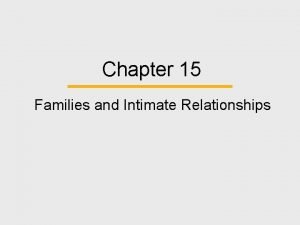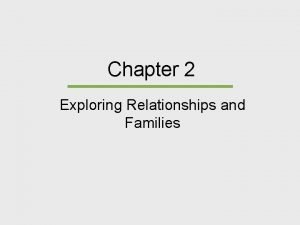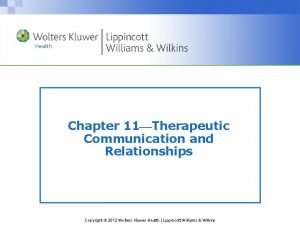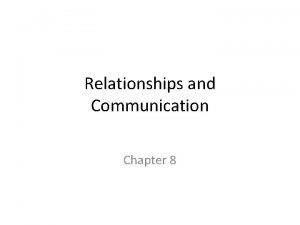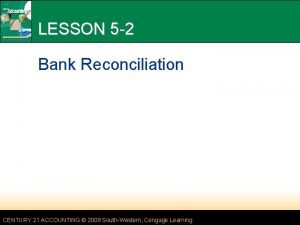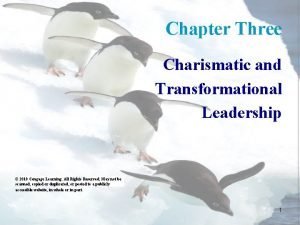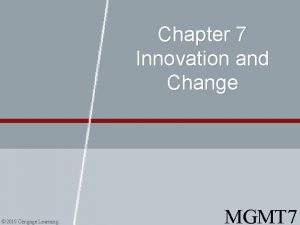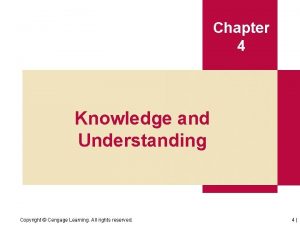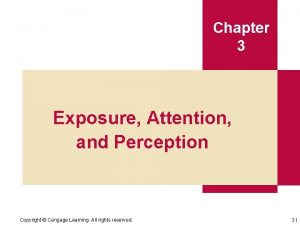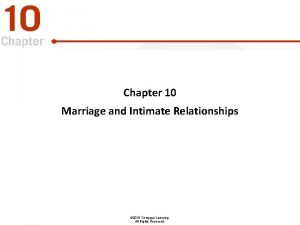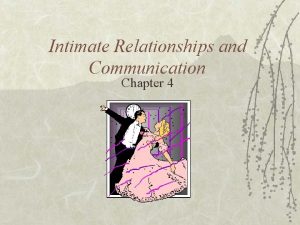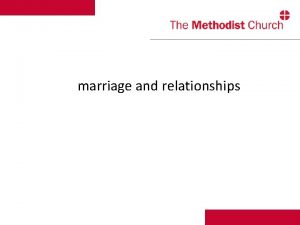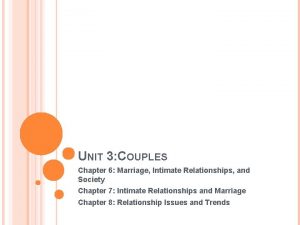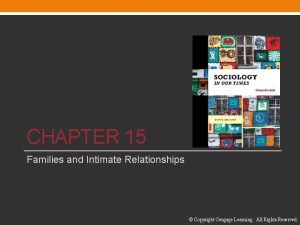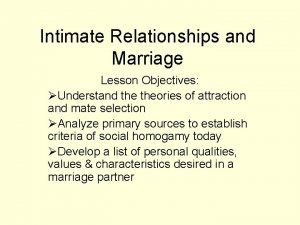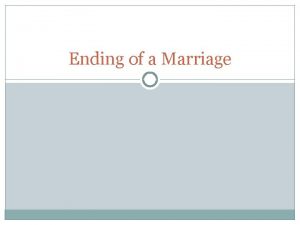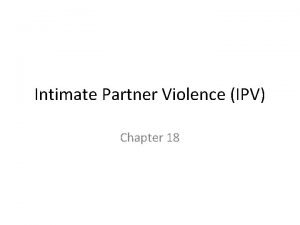Chapter 10 Marriage and Intimate Relationships 2015 Cengage

























































- Slides: 57

Chapter 10 Marriage and Intimate Relationships © 2015 Cengage Learning. All Rights Reserved.

Challenges to the Traditional Model of Marriage LEARNING OBJECTIVES • Discuss six social trends that are affecting the institution of marriage. © 2015 Cengage Learning. All Rights Reserved.

Challenges to the Traditional Model of Marriage, continued • Marriage – “the legally and socially sanctioned union of sexually intimate adults” • Traditionally, it has also included: – Economic interdependence – Common residence – Sexual fidelity – Shared responsibility for children © 2015 Cengage Learning. All Rights Reserved.

Challenges, continued • However, the following social trends have challenged the “traditional” model of marriage: 1. Increased acceptance of singlehood – since the 1960 s, the median age at which people marry has been increasing (see Figure 10. 1) 2. Increased acceptance of cohabitation – “living together in a sexually intimate relationship without the legal bonds of marriage” © 2015 Cengage Learning. All Rights Reserved.

(Data from U. S. Bureau of the Census)

Challenges, continued Trends challenging traditional marriage, continued 3. Reduced premium on permanence 4. Transitions in gender roles – role expectations are more varied, flexible, and ambiguous • More women than ever are in the workforce (see Figure 10. 2) 5. Increased voluntary childlessness 6. Decline of the “nuclear family” © 2015 Cengage Learning. All Rights Reserved.

Data from U. S. Bureau of Labor Statistics

Deciding to Marry LEARNING OBJECTIVES • Describe some cultural influences on marriage. • Identify several factors influencing the selection of a mate. • Summarize evidence on predictors of marital success. © 2015 Cengage Learning. All Rights Reserved.

Deciding to Marry, continued Cultural influences on marriages • Romantic love seems to be experienced in all cultures. • However, there are cultural differences in romantic love as a prerequisite for marriage. – 80% of world cultures practice arranged marriages. – Priority is placed on the family’s, rather than the individual’s, welfare. © 2015 Cengage Learning. All Rights Reserved.

Deciding to Marry, continued Selecting a mate • Monogamy - “the practice of having only one spouse at a time. " • Polygamy - involves “having more than one spouse at a time. " – Polygamy is practiced in many cultures. – It is most common where women have little or no independence, access to education, or political power. • Endogamy – “the tendency of people to marry within their own social group. " • Homogamy – “the tendency of people to marry others who have similar personal characteristics. " © 2015 Cengage Learning. All Rights Reserved.

Deciding to Marry, continued Selecting a mate, continued • Gender and mate selection preferences – Women place more value on a potential partner’s socioeconomic status, intelligence, ambition, and financial prospects. – Men place more value on a potential partner’s youthfulness and physical attractiveness. © 2015 Cengage Learning. All Rights Reserved.

Deciding to Marry, continued Predictors of marital success • Family background – people whose parents were divorced are more likely to divorce themselves. • Age – those who marry at a younger age are more likely to divorce. • Length of courtship – longer periods of courtship are associated with marital success. • Personality – perfectionism and insecurity are loosely associated with marital problems. • Premarital interaction – quality of premarital communication is especially crucial. – In particular, negativity, sarcasm, insulting remarks and being unsupportive are all associated with marital distress. © 2015 Cengage Learning. All Rights Reserved.

Marital Adjustment across the Family Life Cycle LEARNING OBJECTIVES • Explain each stage of the family life cycle. • Identify factors couples weigh in deciding whether to have children, and analyze the dynamics of the transition to parenthood. • Identify common problems that surface as a family’s children reach adolescence, and discuss the transitions that occur in the later stages of the family life cycle. © 2015 Cengage Learning. All Rights Reserved.

Marital Adjustments, continued • The family life cycle is “an orderly sequence of developmental stages that families tend to progress through. " • Mc. Goldrick’s (1988, 1999) model outlines the special challenges that are faced by couples as they progress through six stages of family life (see Figure 10. 5). 1. Between families: the unattached young adult – As people postpone marriage, this stage will likely lengthen. 2. Joining together: the newly married couple – This “honeymoon” phase is characterized by © 2015 Cengage Learning. All Rights Reserved.

Based on Carter & Mc. Goldrick, 1988

Marital Adjustments, continued 3. Family with young children • Birth of the first child brings a major transition and potential stress, especially for mothers. • The key to reducing stress during this transition is having realistic expectations. 4. Family with adolescent children • Adolescence is rated as the most difficult stage of parenting, and marital satisfaction is at its lowest point. • Conflict is especially likely between teens (both males and females) and mothers. • In addition, many couples are also caring for their own aging parents. These double responsibilities spurred the term, the “sandwich generation. " © 2015 Cengage Learning. All Rights Reserved.

Marital Adjustments, continued 5. Launching children into the adult world • Also called the “empty nest” phase, it was traditionally thought to create feelings of loss. • However, women’s roles extend beyond parenthood, and this is now generally associated with greater marital satisfaction. • Problems usually only occur when adult children return to “the nest. " 6. The family in later life • Marital satisfaction tends to climb in the postparental period when couples have more time to devote to one another. • This continues until a spouse’s health begins to decline and/or a spouse dies. © 2015 Cengage Learning. All Rights Reserved.

Vulnerable Areas in Marital Adjustment LEARNING OBJECTIVES • Discuss how role expectations, work, financial issues may affect marital adjustment. • Summarize evidence on the relationship between communication quality and marital adjustment. © 2015 Cengage Learning. All Rights Reserved.

Vulnerable Areas, continued Gaps in role expectations • There are now new expectations about marital roles, and women are especially affected. – More women now have demanding careers. – Yet, they are often interrupted to have children or to follow their husbands. • In addition, wives still do 65% of the household chores, even when they work similar hours. © 2015 Cengage Learning. All Rights Reserved.

© Aleksei Potov/Shutterstock. com

Vulnerable Areas, continued Work and career issues • Work and marital adjustment – Husbands and wives struggle to balance the demands of work and family. – However, benefits of multiple roles to both spouses include: • Social support • Increased income • Having more in common © 2015 Cengage Learning. All Rights Reserved.

Vulnerable Areas, continued Work and career issues, continued • Parents’ work and children’s development – Parents often worry about the impact of their dual careers on the children. – However, there is actually little evidence that a mother’s working is harmful to her children, especially after the child is one year of age. © 2015 Cengage Learning. All Rights Reserved.

Vulnerable Areas, continued Financial difficulties • Serious financial worries tend to cause: – Increased hostility in husbands – Increased depression in wives – Lower marital happiness in both spouses • Newlyweds with more consumer debt argue more about money than those who pay off their debt. • Happy couples engage in more joint decision making regarding finances. © 2015 Cengage Learning. All Rights Reserved.

Vulnerable Areas, continued Inadequate communication • Communication difficulties are the most frequently cited problem among both husbands and wives. • Marital satisfaction is correlated with how well conflict is handled, not whethere is conflict. • Research shows unhappy couples – Find it difficult to convey positive messages – Misunderstand each other more often – Don’t recognize they’ve been misunderstood – Use more frequent, negative messages – Differ in the amount of self-disclosure © 2015 Cengage Learning. All Rights Reserved.

Vulnerable Areas, continued Inadequate communication, continued • Five communication patterns that are risk factors for divorce are: 1. Contempt 2. Criticism 3. Defensiveness 4. Stonewalling 5. Belligerence © 2015 Cengage Learning. All Rights Reserved.

Divorce LEARNING OBJECTIVES • Describe the evidence on changing divorce rates and the factors that go in to deciding to divorce. • Analyze how spouses and children tend to adjust to divorce. • Summarize data on remarriage and the impact of stepfamilies on children. © 2015 Cengage Learning. All Rights Reserved.

Divorce, continued • Almost half of marriages end in divorce but individuals underestimate their likelihood of divorcing. • Most divorces occur during the first decade of marriage (see Figure 10. 7), usually due to: – Communication difficulties – Infidelity – Jealousy – Growing apart – Foolish spending behavior – Substance abuse © 2015 Cengage Learning. All Rights Reserved.

Data from National Center for Heath Statistics

Divorce, continued Deciding on a divorce • The decision to divorce is a complex one that is usually the result of a long series of smaller events that unfold over a long period of time. Adjusting to divorce • Divorce is stressful for both spouses. – It has a more negative impact on men’s health and mortality. – It is more difficult and disruptive to women, especially if there are children. © 2015 Cengage Learning. All Rights Reserved.


Divorce, continued Adjusting to a divorce, continued • Preoccupation with an ex-spouse is also associated with poorer adjustment. • Factors associated with favorable adjustment after a divorce include: – Having higher income – Getting remarried – Having more positive attitudes about divorce – Being the partner who initiated the divorce © 2015 Cengage Learning. All Rights Reserved.

Divorce, continued Effects of divorce on children • After a divorce, many children exhibit: – Depression and/or anxiety – Nightmares, dependency – Aggression, withdrawal, or distractibility – Lowered academic performance – Reduced physical health – Precocious sexual behavior – Substance abuse © 2015 Cengage Learning. All Rights Reserved.

Divorce, continued Effects of divorce on children, continued • However, it should be noted that: – Divorce can have highly varied effects on children that depend on a complex array of factors. – Finally, sometimes divorce can actually have positive effects on children IF it reduces or removes conflict that was present in their married parents. © 2015 Cengage Learning. All Rights Reserved.

Divorce, continued Remarriage and Stepfamilies • The majority of divorced people eventually remarry. • However, divorce rates are slightly higher for second, than for first, marriages. • Stepfamilies, or blended families – “in which both spouses bring children from a previous relationship” are increasingly common and present unique adjustment challenges (see Figure 10. 8). © 2015 Cengage Learning. All Rights Reserved.

Source: Adapted from Papernow, P. L. (1993). Becoming a stepfamily: Patterns of development in remarried families. San Francisco: Jossey-Bass. Reprinted by permission of the author.

Alternative Relationship Lifestyles LEARNING OBJECTIVES • Discuss homosexual and heterosexual couples in regard to the dynamics of their intimate relationships and the adjustment of children. • Discuss the prevalence of cohabitation and its relationship to marital success. • Describe stereotypes of single life, and summarize evidence on the adjustment of single people. © 2015 Cengage Learning. All Rights Reserved.

Alternative Relationship Lifestyles, continued Gay relationships • The term gay refers “to homosexual men and women who seek committed emotional-sexual relationships with members of the same gender. " – Most homosexual women prefer the term lesbian. • 40 -60% of gay males and 45 -80% of lesbian females are in committed relationships. • About half of male couples have “open” sexual relationships, however. © 2015 Cengage Learning. All Rights Reserved.

Alternative Relationship Lifestyles, continued Gay relationships, continued • Same-sex marriage – Americans continue to be divided over the morality of homosexual partnerships. – A 2012 Gallup poll found about half of Americans believe same-sex marriages should be legally recognized (see Figure 10. 9). © 2015 Cengage Learning. All Rights Reserved.

Adapted from Newport, 2012

Alternative Relationship Lifestyles, continued Gay relationships, continued • Comparisons to heterosexual couples – Gay couples do exist in a different social context and are subject to more prejudice and discrimination. – They also do not often enjoy the same legal status and rights as married heterosexual couples. © 2015 Cengage Learning. All Rights Reserved.

Alternative Relationship Lifestyles, continued Gay relationships, continued • However, gay relationships do have: • Similar levels of love and commitment • Similar overall levels of satisfaction • Similar levels of sexual satisfaction • The same relationship goals • Similar predictors of success • Similar sources of conflict and patterns of conflict resolution © 2015 Cengage Learning. All Rights Reserved.

Alternative Relationship Lifestyles, continued Gay relationships, continued Gay parenting • Gays and lesbians are thought of more as individuals, than as members of families. – In fact, gays and lesbians are very involved with their families. – Overall adjustment of children of gay parents is similar to children of heterosexual parents, and they are no more likely to become gay than are children of heterosexual parents. © 2015 Cengage Learning. All Rights Reserved.

Alternative Relationship Lifestyles, continued • Cohabitation – “living together in a sexually intimate relationship outside of marriage” – There has been a large increase in the number of couples who cohabitate (see Figure 10. 10). – Many couples use cohabitation as a “trial marriage”, hoping to ensure success. – However, cohabitation is actually associated with increases in marital discord, not success. © 2015 Cengage Learning. All Rights Reserved.

Based on U. S. Census data

Alternative Relationship Lifestyles, continued Remaining single • Many factors have contributed to the growth of the single population, including – Increased age at which people marry – Increased rate of divorce • Although singles are either stereotyped as “bitter and unhappy” or as “bar-hopping socialites”, there is little support for either. – Compared to married people, singles do exhibit slightly worse mental and physical health and rate themselves as less happy. – However, the difference is modest and applies more to men than to women. © 2015 Cengage Learning. All Rights Reserved.

Application: Understanding Intimate Partner Violence LEARNING OBJECTIVES • Discuss the incidence of partner abuse and the characteristics of batterers, and explain why women stay in abusive relationships. • Discuss the incidence and consequences of date rape as well as the factors that contribute to it. • Understand ways to reduce the likelihood of date rape. © 2015 Cengage Learning. All Rights Reserved.

Application: Intimate Partner Violence, continued Intimate partner violence – “is aggression toward those who are in close relationship to the aggressor. " • It can take many forms, including: – Psychological abuse – Physical abuse – Sexual abuse • Two common types are partner abuse and date rape. © 2015 Cengage Learning. All Rights Reserved.

Application: Intimate Partner Violence, continued Partner abuse often includes these forms of battering: • Physical abuse (e. g. , kicking or choking) • Emotional abuse (e. g. , humiliation, control, withholding money) • Sexual abuse (e. g. , using sex to control, manipulate, or demean the other) © 2015 Cengage Learning. All Rights Reserved.

Application: Intimate Partner Violence, continued Partner Abuse, continued Incidence and consequences • Men and women are victimized, although women are victimized much more frequently. • Women are victims in 85% of nonfatal crimes, and are victims in 75% of murders committed by spouses. • Victims suffer from anxiety, depression, feelings of helplessness and PTSD. • Children who witness violence are at risk for anxiety and depression. © 2015 Cengage Learning. All Rights Reserved.

Application: Intimate Partner Violence, continued Partner abuse, continued Characteristics of batterers • Risk factors associated with domestic violence include: – Unemployment – Drinking and drug problems – Tendency to anger easily – Attitudes that condone aggression – High stress – Males exposed to violence as children © 2015 Cengage Learning. All Rights Reserved.

Application: Intimate Partner Violence, continued Partner abuse, continued Why do people stay in abusive relationships? • Fear of economic hardship • They have nowhere else to live • They feel guilt and shame and do not want to face family and friends • They fear that leaving will cause more severe abuse or murder (statistics support this fear) © 2015 Cengage Learning. All Rights Reserved.

Application: Intimate Partner Violence, continued Date rape - “refers to forced and unwanted intercourse in the context of dating. " • It can occur on first dates, after many dates, or even between engaged couples. • Force used is typically verbal or physical coercion; may involve a weapon. • Incidence and consequences – Most victims are raped by someone they know. – Rape by someone you have trusted is particularly traumatic. – Consequences include depression, posttraumatic stress, and risk for suicide. © 2015 Cengage Learning. All Rights Reserved.

Application: Intimate Partner Violence, continued Date rape, continued • Contributing factors: – Alcohol & drugs (especially “date rape” drugs) – Gender differences in sexual standards – Miscommunication about whether the woman consents to sex – Males who are impulsive, low in empathy, hostile toward women, heavy alcohol users, endorse stereotypes about male dominance, and have had more sex partners than age-mates. © 2015 Cengage Learning. All Rights Reserved.


Application: Intimate Partner Violence, continued Contributing factors, continued • Men are more likely to be offenders if: – They are impulsive, low in empathy, and hostile toward women. – They are heavy drinkers. – They endorse traditional stereotypes about male dominance. – They have had more consensual sex partners than their age-mates. – They have poor anger management skills. © 2015 Cengage Learning. All Rights Reserved.

Application: Intimate Partner Violence, continued Contributing factors, continued • Situational factors can increase likelihood of date rape. It is more likely if: – The man knows the woman. – They are in a more isolated setting. – They have had more consensual sexual activity. – The man has misperceived the woman’s interest in sex in the past. © 2015 Cengage Learning. All Rights Reserved.

Application: Intimate Partner Violence, continued Protecting oneself from date rape 1. Be aware of excessive alcohol and drug use, which may undermine self-control in sexual interactions. 2. Do not leave your drink unattended. 3. When dating someone new, avoid private places. 4. Watch out for your friends. 5. Clearly communicate your feelings and expectations about sexual activity. © 2015 Cengage Learning. All Rights Reserved.
 Intimate relationships, marriages, and families 9th edition
Intimate relationships, marriages, and families 9th edition Define the relationship chapter 7
Define the relationship chapter 7 Love and communication in intimate relationships
Love and communication in intimate relationships Intimacy after incarceration
Intimacy after incarceration Intimate family chapter 6
Intimate family chapter 6 Intimate family chapter 6
Intimate family chapter 6 Meaning of initmacy
Meaning of initmacy Intimate family chapter 2
Intimate family chapter 2 What is intimate distance
What is intimate distance Consultative register examples
Consultative register examples Dewgarden foaming intimate wash benefits
Dewgarden foaming intimate wash benefits Zones of space communication
Zones of space communication Intimate zone in communication
Intimate zone in communication Intimate antonym
Intimate antonym Me line 02 intimate
Me line 02 intimate Abcde of intimate relationship
Abcde of intimate relationship The spyware used in intimate partner violence
The spyware used in intimate partner violence Pharyngorrhea
Pharyngorrhea Cengage chapter 7
Cengage chapter 7 2009 delmar cengage learning
2009 delmar cengage learning Chapter 13 challenge problem accounting
Chapter 13 challenge problem accounting Cengage chapter 7
Cengage chapter 7 Cengage learning heart diagram
Cengage learning heart diagram Chapter 8 the digestive system
Chapter 8 the digestive system Alges root word
Alges root word Matching muscle directions and positions
Matching muscle directions and positions Cengage medical terminology chapter 1
Cengage medical terminology chapter 1 Cengage sequence and series
Cengage sequence and series Matrix all formula
Matrix all formula Cengage anatomy and physiology
Cengage anatomy and physiology Cengage differential equations
Cengage differential equations Century 21 bank
Century 21 bank Separation of variables differential equations
Separation of variables differential equations Chapter 6:2 interpreting word parts
Chapter 6:2 interpreting word parts Cengage learning heart diagram
Cengage learning heart diagram Cengage
Cengage Cengage
Cengage Cengage
Cengage South-western cengage learning
South-western cengage learning Cengage
Cengage Cengage
Cengage Cengage
Cengage 2009 delmar cengage learning
2009 delmar cengage learning Cengage learning heart diagram
Cengage learning heart diagram 1/52 medical terminology
1/52 medical terminology Cengage learning australia
Cengage learning australia 2009 delmar cengage learning
2009 delmar cengage learning Cengage learning
Cengage learning Cengage learning
Cengage learning Module 2 computer concepts skills training
Module 2 computer concepts skills training Cengage
Cengage Wadsworth cengage learning
Wadsworth cengage learning Cengage
Cengage Cengage learning
Cengage learning Cengage
Cengage Cengage learning plant cell
Cengage learning plant cell Cengage
Cengage Cengage learning
Cengage learning
